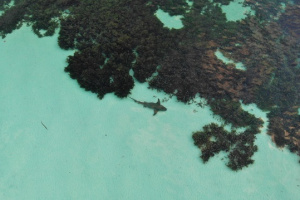Seychelles' media brush up on seagrass and carbon mapping
General |Author: Rita Joubert-Lawen Edited by: Betymie Bonnelame | January 25, 2024, Thursday @ 16:37| 17219 views
Before the mapping exercise, Seychelles had very limited data on its seagrass meadows. (Mathew Morgan)
(Seychelles News Agency) - Local media practitioners learned more about the latest developments in the seagrass and carbon mapping project now in its second phase in Seychelles in a workshop on Thursday.
The workshop was organised by the Seychelles Conservation and Climate Adaptation Trust (SeyCCAT). Presentations were made about the Seychelles Marine Spatial Plan, Blue Carbon Ecosystems, the Carbon Mapping Element – the seagrass aspect – and one specifically about the media being an advocate for seagrass Blue Carbon Ecosystems.
"We are hoping that once the media houses' representatives have attended the workshop, it will help teach them about seagrass as well as help them develop an affinity for the topic," said SeyCCAT's coastal wetlands and climate change project manager, Annike Faure.
She said, "We have invited our media partners who have been there since the beginning of the journey as well as those who are new to the topic to learn more of the processes, our achievements, and our lessons learned."
Faure added that "we want to work closer with the media to give them the information they need about seagrass - which will help them when they are informing people."
The Seychelles' seagrass and carbon mapping project, which cost around $1 million, was done in three main phases: mapping seagrass using satellite imagery; data field collections on seagrass meadows; and data analysis on seagrass extend and carbon stock.
Before the exercise, Seychelles, a group of 115 islands in the western Indian Ocean with an Exclusive Economic Zone (EEZ) of 1.4 million square kilometres, had very limited data on its seagrass meadows.
Now that the second phase of the project is coming to an end, in March 2024, SeyCCAT is planning to provide more information about the techniques of how to rehabilitate and restore seagrass and how to go about conserving it so that Seychelles can achieve the 100 percent commitment in 2030.
Seychelles made a commitment at the 27th Conference of the Parties (COP27) in Sharm El-Sheikh, Egypt to move to 100 percent protection of all its mangroves and seagrass meadows, adding to the already 32 percent protection of its ocean and 50 percent of its forests.
Back
